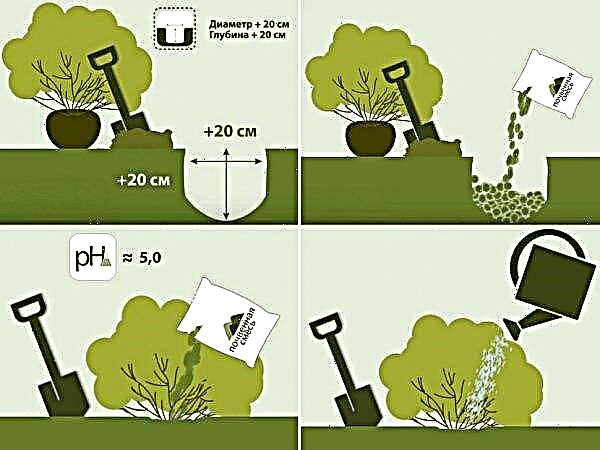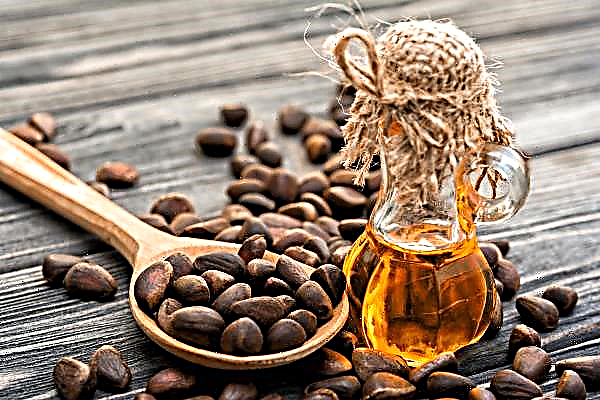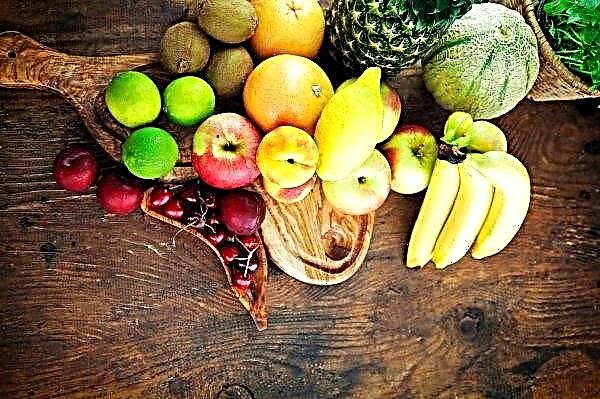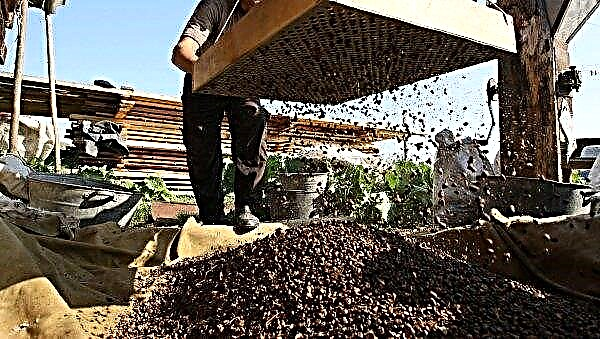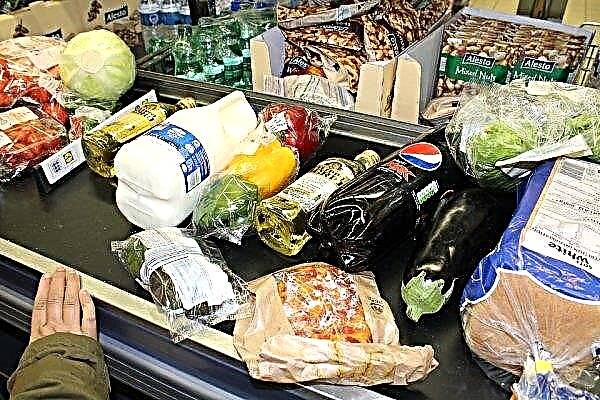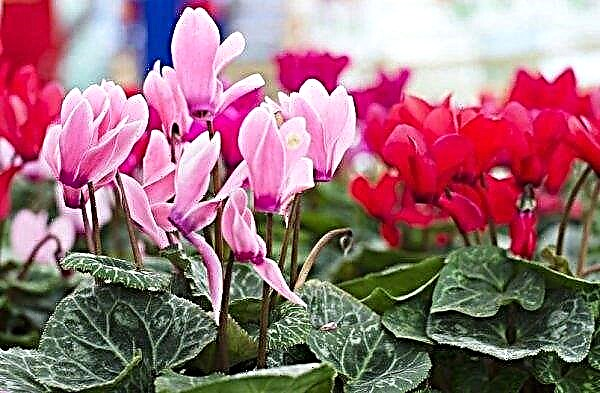It is important for the gardener to know for what economic purposes these or those varieties of tomatoes are suitable. This helps to rationally use the crop. Juiciness, ripening, taste, aroma - these and other characteristics affect the choice of cooking method. In the article we will talk about the variety of tomatoes Banana red, and about why this recently appeared variety managed to gain popularity.
Description and characteristics of the variety
The name of the variety was due to its elongated shape. Being bred by Russian breeders specifically for cultivation both in the southern regions and the middle lane, and in the harsh northern climate, "Red Banana" has the following characteristics:
- early ripening period (fruits ripen in amicable form already by 85–90 days after emergence of seedlings);
- semi-determinant type of bushes (reach 0.7–1.2 m in height);
- flower brushes appear above 8–9 leaves, then alternate through each pair of leaves;
- one brush holds 8-12 berries;
- moderate number of stepsons, if the height of the bush exceeds 80 cm, it is recommended to form in 2 stems;
- average yield (2.7–3.3 kg per bush);
- high shelf life of fruits, withstand long transport;
- fruits of a cylindrical shape, bright red, in length reach 5-12 cm;
- the pulp is juicy, without white veins;
- the weight of a tomato varies from 70 to 120 grams;
- dense skin, not prone to cracking;
- the taste is fresh, not pronounced;
- high solids content in fruits (therefore not suitable for making juices).

Advantages and disadvantages
Based on the description of the variety, we can conclude about the advantages and disadvantages of its cultivation.
- Grade advantages:
- gives a good early harvest;
- can be stored up to 3 months;
- ideal for preservation and pickles due to its compactness and dense peel;
- has an excellent trade dress;
- not susceptible to disease.
- The disadvantages of the variety:
- modest taste in fresh form;
- not recommended for juice;
- low immunity to fungi;
- pinching may be required depending on the height of the bush.
How to plant and grow tomatoes at home?
Despite the endurance inherent in this variety, it requires certain growing conditions and quality care.
Did you know? Tomatoes become healthier after heat treatment than raw. Upon evaporation and frying, they increase the concentration of lycopene - a substance that acts on the human body as an antioxidant.
Growing conditions
This tomato is warm and photophilous, therefore the landing site (whether it is open ground or a greenhouse) needs good lighting (light contributes to the synthesis of protein necessary for growth) and protection from strong winds. For seed germination, a temperature of +20 ... + 25 ° С and a humidity of 60–70% are required. In areas with very hot climates it is advised to pull a shade net over the tomatoes during the day.
Soil treatment
The best option is to buy soil specifically designed for growing tomatoes. Such soil is balanced in acidity and minerals. If you prepare the mixture yourself, then you need to start in the fall.
This will require:
- garden land - 1 part;
- peat (with an acidity of 6.5) - 2 parts;
- river sand - 0.5 parts;
- humus - 1 part;
- wood ash (1 cup per bucket of mixture).
- complex fertilizer.
Important! On the ground, which is part of the soil for tomato seedlings, nightshade crops should not have grown over the past year. Ideal predecessors – zucchini, carrots, cabbage, cucumbers.
The resulting mixture must be sieved and disinfected a week before sowing, calcined in an oven or oven. After this procedure, sphagnum moss or perlite can be added to the soil. Soil in the end should be loose, breathable and water-absorbing.
Planting Material Processing
Due to the fact that the variety in question was not protected against fungal infections as a result of selection, planting material must be treated with a weak warm solution of potassium permanganate or fungicide. To do this, the seeds are placed in a solution for 15 minutes.
Sowing technology
The sowing process includes the following actions:
- 60–65 days before the future seedlings are planted in open ground, the seeds are sown in peat tablets, and then in separate containers, which are placed in 2 cm deep wells. You can skip the sowing stage in peat tablets, but, according to experienced gardeners, this is a two-stage sowing helps to get better and healthier seedlings.
- Boxes with sown seeds are placed on the windowsill from the sunny side. You can optionally use the lamp.
- After landing in the holes, the crops are covered with polyethylene or glass to create the desired microclimate.
- Water as needed.
Important! When hardening, you should remember about the inadmissibility of finding seedlings at temperatures below +8 ° C and under direct sunlight. Start with half an hour, gradually bringing the time spent on the street to 8-10 hours.
Preparing for transplanting seedlings
Crops emerge in a week. Pickling seedlings (transplanting into a large container) is performed after the appearance of the first leaves. Regular hardening (short-term placement of seedlings in open air) begins 2-3 weeks before planting. Watering stops for a week, which helps to increase the cold resistance of plants.
Planting seedlings in a permanent place
Landing in open ground is carried out after the end of night frosts and consists of the following steps:
- Dig holes 1.5 cm deep. Wells should be 30 cm apart.
- Pour warm water or a weak solution of potassium permanganate into each well.
- Place 4-5 seeds in one well, laying them in a circle.
- Pour on top with a half-centimeter layer of soil. Pour with warm water.
- Cover each well with a glass jar or half a plastic bottle.
- Install plastic arcs around the beds, on which to stretch a transparent film.

Features of tomato care
Planted seedlings require care, which consists in fertilizing, watering, pruning, tying the bush, weeding. Consider each of the processes.
Fertilizer
Mineral fertilizing is better to use complex (phosphorus, potassium, nitrogen, copper) and fertilize the soil with them every 2 weeks during irrigation. Fertilizers have proven themselves well:
- "Nanovit";
- Mivena
- "Yara Vila".
Watering
Irrigation with water is done under the root, the leaves should remain dry. Watered in the morning or evening. The frequency of irrigation depends on the condition of the earthen coma, both its dryness and stagnation of water are equally undesirable.
Stepson
For Red Banana, a 2-stem bush is recommended. The first pinching is combined with a garter. This should be done until the shoots have exceeded 5 cm and before the first brush blooms.
The technology of pinching is as follows:
- The main rule: you need to remove the stepsons manually by wearing thin silicone gloves. The use of scissors increases the risk of transmission of diseases from one plant to another.
- It is necessary to prepare in advance a disinfectant solution for rinsing hands after each bush.
- Pinching is done in the morning, in dry weather. The day before, the plants are not watered or fertilized.
- You need to grab the escape with your fingers on top and break off. At the site of the cliff, a wound may form, which is treated with ash. The removed stepson is left on the ground to fertilize the soil.

There are two main methods for growing a bush in 2 stems.
- At the seedling stage. To do this, pinch the upper part of the young plant over the second leaf. After from the sinuses of the leaves, two shoots begin to grow, which will subsequently be the stems.
- After landing. A short reserve stepson is left under the first inflorescence. After two brushes and several leaves grow on it, pinch the shoot.
Did you know? Protecting hands when working with tomatoes is necessary not only for the prevention of plant diseases, but also for your own safety. In the green parts of the bush contains solanine, which, getting on the skin can cause allergic reactions, itching, hyperthermia. Perhaps this is the reason for the ancient myth of tomato toxicity.
Bush tying
The plant must be tied up, otherwise the bush will spread along the ground without support.
In the open ground, this is done by the following methods:
- Supporting. Take wooden pegs in an amount equal to the number of plants. Their length should be equal to the height of the bush plus 40 cm (reserve for driving support into the ground and growth reserve for the bush). The supports are driven in at a distance of 20 cm from the plant, and the tomato is tied to them with strips of any synthetic fabric (a popular option is nylon tights cut into ribbons).
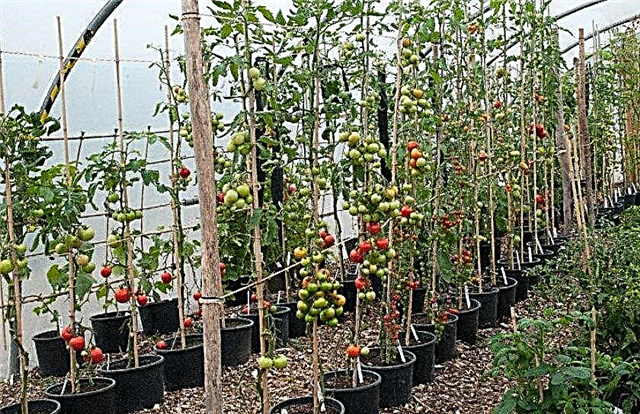
- Tapestry. At the opposite ends of the garden, stable columns are installed with a height of at least 1.5 m. Between them they put a trellis, which you can make yourself or buy a finished one. Tomatoes are tied to the trellis at the top with a rope.

Weeding
Weed grass should be removed before each watering. In addition, the soil must be mulched, creating a protective layer.
For this purpose, environmentally friendly materials such as:
- hay;
- straw;
- compost;
- sawdust;
- buckwheat husks, sunflowers.
Weather and disease resistant
Specialists note the endurance of this variety. It tolerates sudden temperature changes, when in the middle of a hot summer, a cold snap suddenly occurs due to a cyclone. Temporary cessation of watering is also not disastrous for him. Immunity to diseases such as fusarium, late blight and tobacco mosaic, high. Unfortunately, the variety is susceptible to cladosporiosis and requires regular prophylaxis (spraying with fungicides in the pre-planting period and in the process of setting inflorescences). Bordeaux liquid (copper sulfate in combination with diluted lime) has proven effectiveness, but it must be remembered that it is not used simultaneously with phosphate fertilizers.
Unfortunately, the variety is susceptible to cladosporiosis and requires regular prophylaxis (spraying with fungicides in the pre-planting period and in the process of setting inflorescences). Bordeaux liquid (copper sulfate in combination with diluted lime) has proven effectiveness, but it must be remembered that it is not used simultaneously with phosphate fertilizers.
Harvesting and storage
The fruits are harvested as they ripen, with proper care and the absence of freezing until November. You need to remove them from the bush along with the peduncle, this contributes to longer storage. This variety can be plucked a little immature, tomatoes mature in the sun. For storage, the fruits are stacked in wooden boxes in rows and put away in a cool place (basement, cellar). The variety can be stored for 2-3 months without loss of quality.
Variety Banana red for a few years from the moment of emergence managed to fall in love with domestic gardeners. It ripens early, is unpretentious, gives a good harvest, is stored for a long time and is suitable for cooking tomato pastas, pickles, soups, as well as drying. In order not to be disappointed in this tomato, you need to remember that it is not used in the production of juices, and that its taste is revealed in conservation, and not in fresh form.



